|
The Ray Guns of 1950s Space Opera
Although the Buck Rogers and Flash Gordon comic strips and radio shows of the 1930s and 1940s first created the market for space adventure, the development of television in the 1950s added a new dimension to this popular preoccupation. The first space TV series was "Captain Video," which began in 1949; then in the 1950s the television screen was virtually invaded by adventurous space heroes like Tom Corbett Space Cadet, Buzz Corry of the Space Patrol, and Rocky Jones Space Ranger. Part of the "cutting edge" of the new information and entertainment technology, these early science fiction television shows often utiilized live broadcasts and innovative special effects to reach audiences in a more immediate way than had radio and newspaper drama. Like the western "horse operas" that were also popular at this time, "space opera" offered visual models for children's action play as well as popularizing the props used by television adventurers.
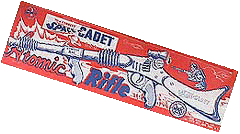 Among the most popular props used in 1950s space opera were ray guns. At least twelve toy space guns were sold in association with television space adventure shows during this period. Merchandised as premiums or sold as toys in retail stores, these space guns,are among the most beautiful and intersting space toys produced at the time, and they encouraged children to "play along" and more completely identify with their favorite space heroes. Among the most popular props used in 1950s space opera were ray guns. At least twelve toy space guns were sold in association with television space adventure shows during this period. Merchandised as premiums or sold as toys in retail stores, these space guns,are among the most beautiful and intersting space toys produced at the time, and they encouraged children to "play along" and more completely identify with their favorite space heroes.
(The information on this page has been gathered from a number of sources. Most notable is the definitive study of Space Opera, the website Solarguard, designed and run by Cadet Ed Pippin. Ed has also contributed images of a number of his own toy guns to be illustrated here as has Cadet Chuck Lassen, who generously checked the text for errors. In addition I have relied on Hakes Price Guide to Character Toy Premiums (1st Edition, Gemstone Publishing, 1996) and Space Adventure Collectibles by T.N. Tumbusch (Tomart Publications, 1996.)
Captain Video
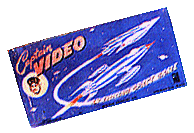 Captain Video, television's first space hero, premiered in June of 1949, beating Buck Rogers by a year. The show was featured on the now defunct Dumont network with Richard Coogan as the Captain, a role taken over in 1951 by Al Hodge, the radio voice of Green Hornet. Captain Video was a master scientist and inventor, and leader of an elite corps known as the Video Rangers. The series, one of the most popular children's shows of its time, was notoriously low-budget, with props made of cardboard or household items, but it featured many wonderful and imaginative futuristic devices like an Opticon Scillometer, a Radio Scillograph, a Cosmic Ray Vibrator and an Atomic Rifle. However, the most important device was a futuristic television called a "Remote Tele Carrier" which allowed the Captain to see anyone, anywhere. In the early days of the show, the Captain often used this device to give himself, and the other actors in the series, a break by switching on the Tele Carrier in order to look in on the "Video Rangers of the Wild West," reruns of old western footage. The series ended its network run in 1955 but was broadcast locally in New York for two years.Sponsors such as Post cereals and Power House candy bars offered many premiums like space vehicles, a helmet, a flashlight and goggles. Captain Video, television's first space hero, premiered in June of 1949, beating Buck Rogers by a year. The show was featured on the now defunct Dumont network with Richard Coogan as the Captain, a role taken over in 1951 by Al Hodge, the radio voice of Green Hornet. Captain Video was a master scientist and inventor, and leader of an elite corps known as the Video Rangers. The series, one of the most popular children's shows of its time, was notoriously low-budget, with props made of cardboard or household items, but it featured many wonderful and imaginative futuristic devices like an Opticon Scillometer, a Radio Scillograph, a Cosmic Ray Vibrator and an Atomic Rifle. However, the most important device was a futuristic television called a "Remote Tele Carrier" which allowed the Captain to see anyone, anywhere. In the early days of the show, the Captain often used this device to give himself, and the other actors in the series, a break by switching on the Tele Carrier in order to look in on the "Video Rangers of the Wild West," reruns of old western footage. The series ended its network run in 1955 but was broadcast locally in New York for two years.Sponsors such as Post cereals and Power House candy bars offered many premiums like space vehicles, a helmet, a flashlight and goggles.
Captain Video Ray Guns
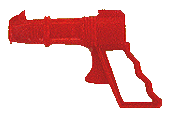 |
|
The Captain Video Secret Ray Gun was offered as a premium by Power House candy in the 1950s. This four inch long battery operated gun came with a "Luma-Glo" card which produced glowing messages in the dark when the card was illuminated by pointing the gun at it. |

|
|
According to Cadet Chuck Lassen, there was another Captain Video ray gun offered as a Power House premium. "It was a red, plastic gun that shot rubber bands. You could load it up with six, and if you did everything just right you could sometimes shoot them off one at a time with each successive trigger pull. The gun came with a small, black, hard plastic delta-winged jet plane which you could place on top of the gun and launch with one of the rubber bands. It was a formidable projectile which I'm sure could not be sold today." If anyone knows more about this gun, or has a picture of it, please let me know. |
Space Patrol
The exploration of the solar system was nearly complete by the thirtieth century, creating a need for a universal government system. The leaders of the variaous planets met on Earth and established the United Planets of the Universe.To prevent political conflicts, the United Planets government was located on a man-made planet. This world was known as Terra and contained soil from 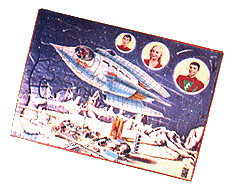 each of the nine planets in its core. each of the nine planets in its core.
The Space Patrol was created as the military force for this new system, with Commander Buzz Corry, played by Ed Kemmer, as commander-in-chief. Corry was accompanied by Cadet Happy, girlfriend Carol Carlisle, second in command Major Robertson, and rehabilitated criminal Tonga. Together they confronted such villians as Mr. Proteus, Captain Dagger, the Space Spider, and the evil Black Falcon (Prince Baccarati) in never-ending battle to preserve "right, goodness and justice" in the solar system.
"Space Patrol" was launched on March 13, 1950 when it was broadcast locally on KECA-TV in Los Angeles. Six months later it went national on the ABC television and radio networks. It was one of the more enduring space exploration shows on televeision, and ran until February 26, 1955.
A remarkable array of products was sold under the "Space Patrol" name. Including space suits, helmets, communicators, flashlights, trading cards, comic books, and, of course, ray guns, these items were either offered as toys sold in retail stores or as premiums found in the cereal boxes of Ralston Purina Co., Space Patrol's primary sponsor.
Space Patrol Ray Guns
Tom Corbett, Space Cadet
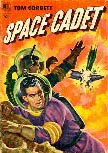 "Tom Corbett," based on Robert Heinlein's novel Space Cadet , is a story of growing up in the Space Academy. Students in the Academy are separated into groups of three - a command, power, and radar cadet. Each member of the group has his own set of responsibilities. The series follows the adventures and trials of the Polaris Crew, the best unit in the academy. The group is led by command cadet Tom Corbett, a natural leader from New Chicago. Accompanying him on the crew are radar expert Roger Manning, and power cadet Astro. "Tom Corbett," based on Robert Heinlein's novel Space Cadet , is a story of growing up in the Space Academy. Students in the Academy are separated into groups of three - a command, power, and radar cadet. Each member of the group has his own set of responsibilities. The series follows the adventures and trials of the Polaris Crew, the best unit in the academy. The group is led by command cadet Tom Corbett, a natural leader from New Chicago. Accompanying him on the crew are radar expert Roger Manning, and power cadet Astro.
"Tom Corbett" was first broadcast on television on October 2, 1950 by CBS. Like many shows in the early days of television, the cadets came into your living room for only 15 minutes, 3 days a week. Scheduli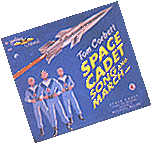 ng for the show was sporadic, and it appeared on four television networks during its five year span (DuMont was the fourth). ng for the show was sporadic, and it appeared on four television networks during its five year span (DuMont was the fourth).
"Tom Corbett" became so popular that in addition to the television series the intrepid space cadet appeared in every media form except films during the 1950s. These included eight hard cover books, fourteen comics, a Sunday and daily newspaper strip, and a radio drama.
Merchandising of Tom Corbett material was extensive, including toys, a watch, lunch boxes, space goggles, rings, patches, and ray guns.
Tom Corbett Ray Guns

|
|
The Tom Corbett Space Cadet Atomic Rifle was made by Marx in the 1950s. One of the most beautiful space rifles made, it is one of the Space Cadet items that was never merchandised as a premium.
|

|
|
The Tom Corbett Space Cadet Sparkling Gun is the second Space Cadet rifle made by Marx. A wind-up toy, this gun was also produced, using a different lithography, as a G-Man Submachine Gun.
|
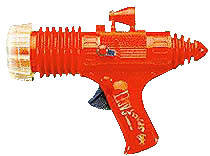 |
|
The Tom Corbett Atomic Pistol by Marx is a flashlight gun made in the late 1950s. This gun is identical to the Space Patrol Atomic Pistol made by the same company at the same time.The gun was also produced in Sweden and called a Cosmic Mars Pistol. Length 8 inches.
|
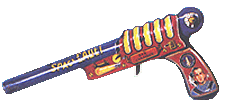
|
|
The Tom Corbett Space Cadet Space Gun was made by Marx around 1952. For this gun, as well as for the Flash Gordon Arresting Ray made at about the same time, Marx used the same tools and dies that had been used to produce the 1930s Flash Gordon Radio Repeater gun. Length 10 inches.
|
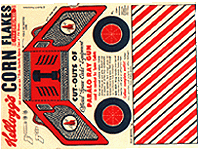
|
|
The Paralo Ray gun was one of a number of cut-outs of "Official Space Cadet Equipment" that was available on the back of Kellogg's Corn Flakes boxes in the 1950s. In addition to the gun, one could also find gauntlets, a visor, and a Space Cadet insignia. This outfit was said to be the same one "used in combat by Space Cadets."
|
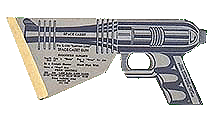 |
|
The Space Cadet Gun is a paper-popper made by Lewtan in the 1950s. This gun could be purchased by any business as an advertising give-away.On one side of the gun it says "Place YOUR AD here!" and on the other side are suggested slogans such as "You'll Get a Bang Out Of...," "For a Bang Up Job See...," and "Be a Straight Shooter If You Buy...." Length 6 1/2 inches. |
Blast Off to More Space Opera Adventure!
To discover more information about the classic television space shows of the 1950s, rev up your jets and blast off to the definitive source for the study of Space Opera, Cadet Ed Pippin's website Solar Guard. Here you can learn all that there is to know about Tom Corbett, Space Patrol, Captain Video, and the many other wonderful science fiction shows of the 1950s. |



 Among the most popular props used in 1950s space opera were ray guns. At least twelve toy space guns were sold in association with television space adventure shows during this period. Merchandised as premiums or sold as toys in retail stores, these space guns,are among the most beautiful and intersting space toys produced at the time, and they encouraged children to "play along" and more completely identify with their favorite space heroes.
Among the most popular props used in 1950s space opera were ray guns. At least twelve toy space guns were sold in association with television space adventure shows during this period. Merchandised as premiums or sold as toys in retail stores, these space guns,are among the most beautiful and intersting space toys produced at the time, and they encouraged children to "play along" and more completely identify with their favorite space heroes. Captain Video, television's first space hero, premiered in June of 1949, beating Buck Rogers by a year. The show was featured on the now defunct Dumont network with Richard Coogan as the Captain, a role taken over in 1951 by Al Hodge, the radio voice of Green Hornet. Captain Video was a master scientist and inventor, and leader of an elite corps known as the Video Rangers. The series, one of the most popular children's shows of its time, was notoriously low-budget, with props made of cardboard or household items, but it featured many wonderful and imaginative futuristic devices like an Opticon Scillometer, a Radio Scillograph, a Cosmic Ray Vibrator and an Atomic Rifle. However, the most important device was a futuristic television called a "Remote Tele Carrier" which allowed the Captain to see anyone, anywhere. In the early days of the show, the Captain often used this device to give himself, and the other actors in the series, a break by switching on the Tele Carrier in order to look in on the "Video Rangers of the Wild West," reruns of old western footage. The series ended its network run in 1955 but was broadcast locally in New York for two years.Sponsors such as Post cereals and Power House candy bars offered many premiums like space vehicles, a helmet, a flashlight and goggles.
Captain Video, television's first space hero, premiered in June of 1949, beating Buck Rogers by a year. The show was featured on the now defunct Dumont network with Richard Coogan as the Captain, a role taken over in 1951 by Al Hodge, the radio voice of Green Hornet. Captain Video was a master scientist and inventor, and leader of an elite corps known as the Video Rangers. The series, one of the most popular children's shows of its time, was notoriously low-budget, with props made of cardboard or household items, but it featured many wonderful and imaginative futuristic devices like an Opticon Scillometer, a Radio Scillograph, a Cosmic Ray Vibrator and an Atomic Rifle. However, the most important device was a futuristic television called a "Remote Tele Carrier" which allowed the Captain to see anyone, anywhere. In the early days of the show, the Captain often used this device to give himself, and the other actors in the series, a break by switching on the Tele Carrier in order to look in on the "Video Rangers of the Wild West," reruns of old western footage. The series ended its network run in 1955 but was broadcast locally in New York for two years.Sponsors such as Post cereals and Power House candy bars offered many premiums like space vehicles, a helmet, a flashlight and goggles.

 each of the nine planets in its core.
each of the nine planets in its core. 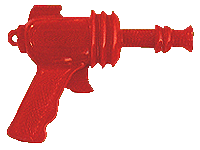
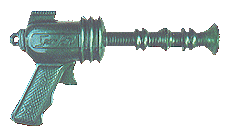
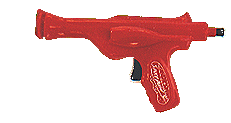
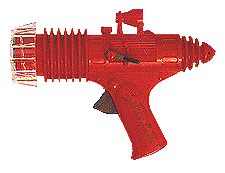

 "Tom Corbett," based on Robert Heinlein's novel Space Cadet , is a story of growing up in the Space Academy. Students in the Academy are separated into groups of three - a command, power, and radar cadet. Each member of the group has his own set of responsibilities. The series follows the adventures and trials of the Polaris Crew, the best unit in the academy. The group is led by command cadet Tom Corbett, a natural leader from New Chicago. Accompanying him on the crew are radar expert Roger Manning, and power cadet Astro.
"Tom Corbett," based on Robert Heinlein's novel Space Cadet , is a story of growing up in the Space Academy. Students in the Academy are separated into groups of three - a command, power, and radar cadet. Each member of the group has his own set of responsibilities. The series follows the adventures and trials of the Polaris Crew, the best unit in the academy. The group is led by command cadet Tom Corbett, a natural leader from New Chicago. Accompanying him on the crew are radar expert Roger Manning, and power cadet Astro.  ng for the show was sporadic, and it appeared on four television networks during its five year span (DuMont was the fourth).
ng for the show was sporadic, and it appeared on four television networks during its five year span (DuMont was the fourth).




